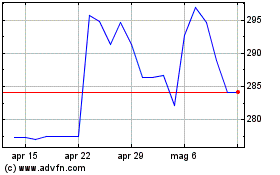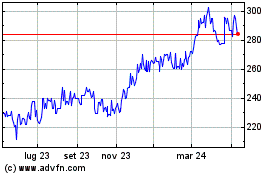By Alice Uribe
SYDNEY -- After wildfires burned through his timber plantation
on southern Australia's Kangaroo Island, Keith Lamb gauged what
could be saved and called his insurer. The conversation didn't go
well: The insurer declined to renew his policy.
As the forestry industry faces increased fire risk amid a
warming climate, companies around the world, including in the U.S.,
are more exposed to losses from blazes than ever before and are
struggling to get insured. Some owners, such as Mr. Lamb, are
paying sharply higher prices to stay protected. Others are buying
insurance for part of their landholdings, while others can't get
coverage at all.
"We got a very, very slim offering," said Mr. Lamb, 54 years
old. "We were successful in obtaining coverage, but it was much
more expensive."
Around 95% of Kangaroo Island Plantation Timber's 14,500 hectare
plantation had been ravaged by fires over a year ago, cutting its
value to around $5 million, from $87 million beforehand. When Mr.
Lamb, KIPT's managing director, found a new insurance policy, fewer
insurers were offering coverage for forests.
Fires have been growing more intense around the world, and the
blazes in Australia in the 2019-2020 summer were unprecedented in
scale, devastating an area the size of Arizona. In New South Wales
state, home to Sydney, more than a quarter of timber plantations
managed by Forestry Corporation NSW on behalf of the government
were damaged. The industry, which typically generates more than
$3.6 billion in annual revenue and is a major exporter to Asia,
will take years to recover.
In California, wildfires burned through 1.7 million hectares
last year, including 60,000 hectares of commercial forests,
according to data from Calforests, which represents the state's
timber industry.
"Most insurance companies are currently writing 'wildfire
exclusions' into any liability coverage, so this insurance has
become very difficult to get," said Rich Gordon, Calforests'
president. "When such insurance is available, the coverage has gone
down and the price has gone up."
Mr. Gordon said U.S. timber companies are absorbing the
additional cost of insurance without laying off workers, but are
fearful of the future if the price of coverage continues to
rise.
It is a warning sign for other industries and communities that
face rising risks from climate change. Agriculture is another
sector on the front lines because a warming climate changes where
farmers can plant crops, while higher carbon dioxide levels can
affect the growth and value of produce, said Australia's Department
of Agriculture, Water and the Environment.
Forestry owners are especially exposed. While livestock farmers
can buy more animals after a fire or crop growers can wait for a
new season, it takes years before seedlings turn into mature
trees.
At KIPT's plantation, pine trees typically take 30 years to
grow. The blue gum trees, a native Australian variety, which made
up most of the estate, more easily adapt to fires and have regrown
shoots. Still, they are harvested 10 years after planting.
In Australia, the mean temperature from 2011 to 2020 was the
highest on record, at nearly a full degree Celsius above average,
Bureau of Meteorology data show. Australia's warmest-ever spring
happened last year. Fires are more likely to start, and continue to
burn, in hot, dry and windy weather because vegetation turns
tinder-dry and is more flammable, the bureau says.
Noticing these trends, insurers are pulling back from providing
coverage. With wildfire seasons lasting longer, Allianz SE last
year changed its approach to Australian homes and businesses such
as timber plantations in high-risk areas.
"The resulting change in Allianz's bush-fire risk appetite has
resulted in a reduction in our willingness to insure higher-risk
properties located in bush-fire-prone areas or the need to increase
premiums for such properties to better reflect their bush-fire
risk," the insurer said.
Across the industry, insurers have estimated losses at $1.78
billion from claims to date from households and businesses affected
by Australia's 2019-2020 fire season.
In the U.S., forest owners have historically been able to buy
insurance that gives them liability coverage for fires that start
on their land and then spread to neighboring properties, but they
aren't covered for fires that start outside their property and
encroach on their lands, said Mr. Gordon, of Calforests.
That is a concern as fire seasons become more intense. Wildfires
throw off hot embers that can start spot blazes several miles away.
Lightning strikes are another threat.
Industrial timber plantations aren't protected under U.S.
government insurance plans that protect other agricultural
operations, such as corn destroyed by a tornado, Mr. Gordon said.
No such insurance pools exist in Australia.
Many forestry owners haven't been able to get insurance as it
isn't widely available, and have relied on strategies such as
carving deep gaps between tree clusters to create fire breaks and
spacing water tanks around plantations, said Brian Shillinglaw,
managing director of New Forests Assets Management Pty Ltd.'s North
American division.
Self-insurance is another tactic, with companies setting aside
capital that can be reclaimed when they suffer losses from fires.
But that is often beyond the finances of smaller forestry
companies.
Hancock Victorian Plantations said it was becoming harder and
more expensive to insure against fire losses in its 240,000
hectares of forest in Australia's Victoria state. The company said
it expects to spend roughly $6.5 million on fire-prevention
measures, excluding insurance costs, in the 12 months through
June.
Even timber companies that have been largely untouched by
wildfires are paying for the risk. New Forests said its insurance
premiums in Australia have nearly doubled over the past two years.
For the current fire season it was able to secure coverage for its
Australian forests, but with tighter terms and conditions.
Jon Gapes, managing director of underwriter Insurance
Facilitators, said smaller plantation owners in Australia were most
at risk of being left without cover. "The cost of it all has just
become too much for some of these," he said.
For Mr. Lamb, losses from the Kangaroo Island fires have been
cushioned by a $49 million payout under his old insurance policy.
Getting coverage again has meant paying a 400% increase on that
policy relative to the value of the remaining trees.
Still, he thinks any coverage is worthwhile given increasing
fire risk and his front-line experience battling the flames a year
ago, a fire in which two firefighters died.
"That day was one of the worst days I've dealt with," Mr. Lamb
said.
Write to Alice Uribe at alice.uribe@wsj.com
(END) Dow Jones Newswires
February 26, 2021 08:14 ET (13:14 GMT)
Copyright (c) 2021 Dow Jones & Company, Inc.
Grafico Azioni Allianz Ag Muenchen Namen (PK) (USOTC:ALIZF)
Storico
Da Feb 2025 a Mar 2025

Grafico Azioni Allianz Ag Muenchen Namen (PK) (USOTC:ALIZF)
Storico
Da Mar 2024 a Mar 2025
